- A detailed account of a 5 day family yatra to
Kashi, Ayodhya and Prayagraj with pictures. Also includes Vedi daan, Pind daan,
key temples and popular places to eat in Kashi.
In the last week of December 2022, I embarked on a spiritual trip to Prayagraj, Ayodhya and Kashi. I had the company of my two kids, spouse, mother, in-laws, sister, brother-in-law and my niece. The main purpose of our trip was to conduct “pind-daan” ceremony for my deceased father in Kashi since it would be his tenth death anniversary in January 2023. Later we added Prayagraj and Ayodhya to the itinerary since they are only a few hours apart from Kashi.
This trip turned out to be one best journeys I
have taken across India, actually across the world (have travelled to ten
different countries). It was an emotional journey but ended up being a very
uplifting one for our souls by the time we returned home i.e. Pune. Usually, I
would drive down to any place in India but this time around we decided to book
flights especially since my mother and father in law have mobility issues being
over 70.
Read by author Drive
from Pune to Spiti Valley
We were planning this trip for the last few
years. However, such spiritual journeys happen only when God wills is a wide
spread belief in Sanatana Dharma. Here is a day-wise comprehensive overview of our trip along with hotel and places visited along with cultural nuances.
Day 1 Reached Prayagraj
Arrived at Prayagraj by a direct flight from Pune. The word Prayagraj means the “king amongst all the Prayags” whereas “prayag” means a place where there is a confluence of rivers. Prayagraj is the place of the Triveni
Sangam (confluence of the Ganga, Yamuna and the hidden Saraswati rivers).
Our flight landed in Prayagraj at 3.30 PM. We visited Anand Bhawan
(Nehru/Gandhi family home) and Shri Bharadwaj Ashram on the way to the hotel.
Shri Bharadwaj Ashram finds several references in the Ramayana and was visited
by Shri Ram and his family during ancient times.
We were astonished to see the number of public
parks in Prayagraj. One these parks was also witness to the last stand of
freedom fighter Chandrashekhar Azad. Stayed overnight at Prayag Inn hotel.
Day 2 Prayagraj-Depature for Ayodhya
All couples in our family group (spouse and I, sister and brother-in-law, my in-laws) performed veni-daan at a Guruji's house near triveni sangam. Prayagraj is the only place in the world where you can perform this ceremony since it has the triveni sangam.
There is a misunderstanding that the “veni-daan” ceremony is a like second marriage of sorts but the Guruji who conducted this ceremony for us said that this is not like a marriage ceremony. It was more like an offering to God and well-being of the couple from this life to the future cycles of birth.
Part of the veni-daan ceremony involves the
husband tying a braid (veni) for their wives. The veni represents the three
rivers of Ganga, Yamuna and the now extinct Saraswati (much like how you see
only two partings of hair where as a braid is made up of three partings of
hair).
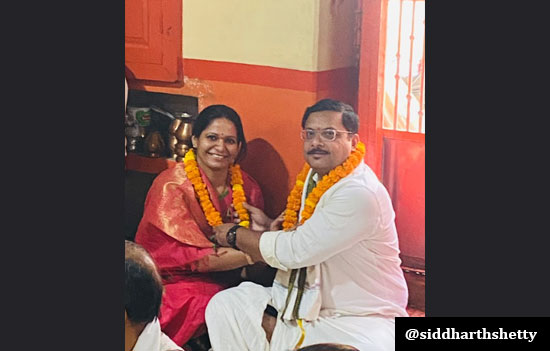 My wife and I performing the “veni-daan” ceremony.
My wife and I performing the “veni-daan” ceremony.
My mother performed the ‘gau-daan’ ceremony at the same place using a silver cow as a symbolical reference for a cow. In the olden days, an actual cow was donated as part of the “gau daan” ceremony.
 My mother performing the “gau daan” ceremony.
My mother performing the “gau daan” ceremony.
Our Guruji who conducted the ‘veni-daan’ and ‘gau-daan’ ceremonies spoke fluent Marathi since his ancestors were from Maharashtra who settled in Prayagraj a couple of centuries ago. His name is Yogesh Pitre. His contacts 9839270537, 9452367799.
After these two ceremonies, we hired a boat for
the Triveni Sangam
(Ganga-Yamuna-Saraswati confluence) snan at triveni sangam point. The boat-mean
create a safe zone at the confluence by trying up boats together and devotees
can bath in a safe area for their Triveni sangam snan well protected from the
strong currents of the Ganga and Yamuna.
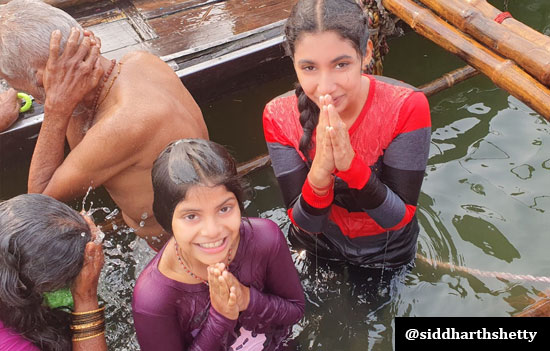 My daughter and niece performing the Triveni sangam snan at Prayagraj.
My daughter and niece performing the Triveni sangam snan at Prayagraj.
We also visited Alopi
Mata temple (a shaktipeeth dedicated to Sati mata and it
is said that her right hand fell at the place where this temple stands today).
This temple also houses all the avatars of Ma Parvati.
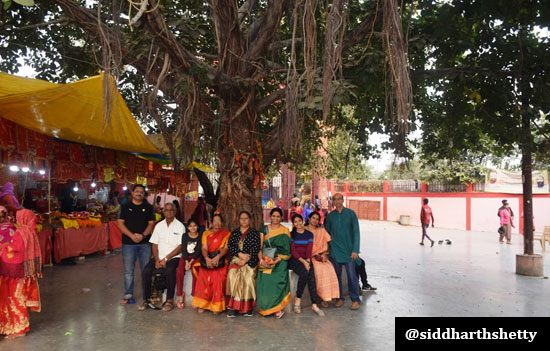 Our family pic in the premises of the Alopi mata temple.
Our family pic in the premises of the Alopi mata temple.
We also visited Bade
Hanumanji temple near triveni sangam. This is where Hanumanji is in a lying state and hence worshipped as “lete Hanumanji.” Had lunch at Sringeri Math. This lunch
arrangement with Sringeri Math was coordinated by Pitre Guruji.
The only thing we didn’t like about Prayagraj is that every local person you engage with is after “tips” from tourists. I mean you expect this at most tourist places but in this case the locals here are much more vocal about tips they expect for even the most basic of services provided. It was equally surprising to see how the attendants at Shri Bharadwaj Ashram also sought donations from every person visiting the ashram.
Post lunch, we travelled by road in a Tempo
Traveller (10 people) from Prayagraj to Ayodhya. Reached hotel Krishna Palace
in Faizabad near Ayodhya. Faizabad is the satellite town of Ayodhya and has
many hotels since the ancient city of Ayodhya cannot add any more hotels. We
had dinner at the hotel and rested for the night.
Day 3 Ayodhya
We were running late in the morning post
breakfast. Most temples in Ayodhya close by 12 pm and re-open after 1 pm. Ram Janma Bhoomi closes at 11 am and re-opens up at 2 pm.
Our Tempo Traveller had to be parked some
distance away from Ayodhya town so we hired two battery operated tuk-tuks to
take us inside the town. All large buses were also parked outside the main
Ayodhya city since these are ancient cities with ancient buildings. The tuk-tuk
guys typically charge anywhere from Rs 300-500 per tuktuk to cover all important
sights and places around Ayodhya.
Our first stop was at Shri Kale Ramji temple in
Ayodhya. This temple apparently houses the original idols of Sri Ram, Sita Mata,
Lakshmanji, Bharatji and Shatrughnji from the original Ram temple that was
demolished by invaders centuries ago. Priests of the temple managed to get
these murtis out of the temple in time and at some point, had consigned them to
the Sarayu River since there was no sight of overthrowing the invaders anytime
soon.
A visiting Maharashtrian religious figure had a
divine vision about these idols lying at the banks of the river. He recovered
them from the riverbank post which they were installed in the present temple.
Since a Maharashtrian had the vision to recover these idols, the management of
this temple was assigned to priests from Maharashtra which has continued to the
current day. Performed pooja at this temple under the presence of head priest
Deshpande Guruji who can be reached on 8808457508 for details.
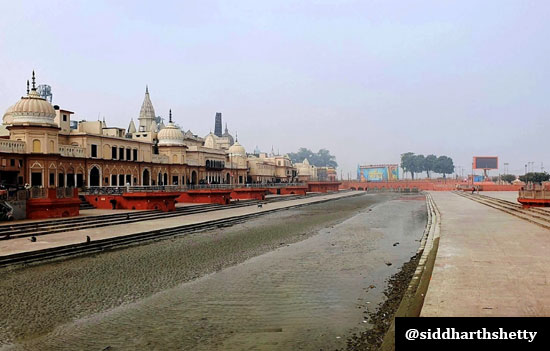 This is the
place which was lit up like a magical world on Diwali evening this year.
This is the
place which was lit up like a magical world on Diwali evening this year.
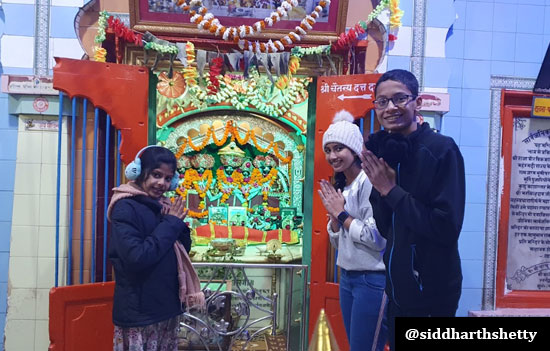 My daughter, niece and son at Shri Kale Ram Mandir, Ayodhya.
My daughter, niece and son at Shri Kale Ram Mandir, Ayodhya.
After this we visited Hanuman Gaddi, Dashrath
Gaddi, Kanak Mahal, Ram Gaddi. Hanuman Gaddi is the only place where you will see Lord Hanuman in a king’s avatar. This is because Shri Ram had handed over the reins of Ayodhya to Hanumanji before undertaking Jal Samadhi in the Sarayu river. Hence, Hanuman Gaddi is the place from where lord Hanuman ruled over Ayodhya in the times to follow.
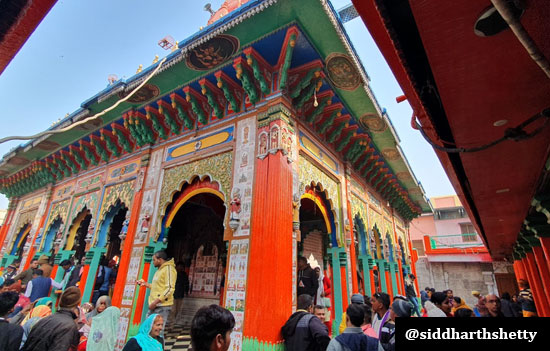 Hanuman Gaddi temple, Ayodhya.
Hanuman Gaddi temple, Ayodhya.
Dashrath Gaddi is the location of Dashrath’s original palace and similarly Ram Gaddi is the place from where Shri Ram ruled over Ayodhya.
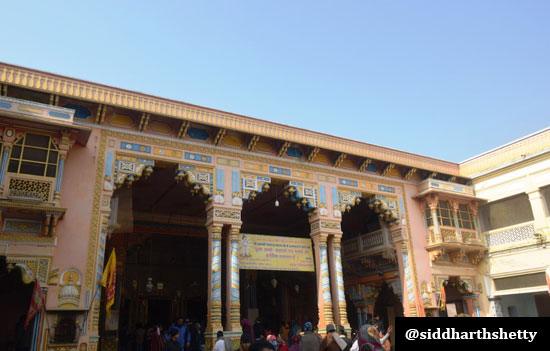 Dashrath Gaddi, Ayodhya.
Dashrath Gaddi, Ayodhya.
Kanak Mahal was a
palace gifted to Sita Ma by Kaikeyi Ma after her marriage to Sri Ram.
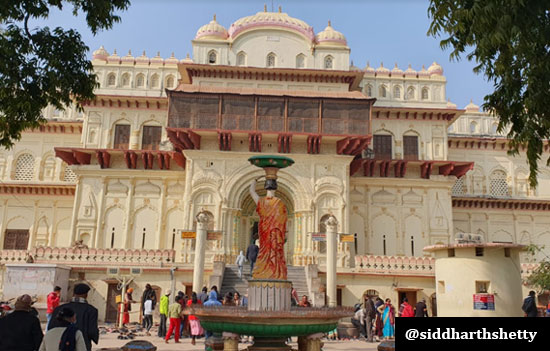 Kanak Mahal
Kanak Mahal
We had lunch at a local hotel in Ayodhya. Post
lunch we lined up for Ram Janmabhoomi temple visit at 1.30 pm. The gates open
at 2. There is a huge rush of devotees so do try to line up early to avoid the
hassle of the crowds later on. Thankfully they have a separate queue for women.
You pass through 3 layers of security checks.
Once these checks have been performed you pass through an enclosed passage that
gives you a sighting of the grand Shri Ram temple that is currently under
construction. You are also able to see the scale model of this upcoming temple
and historical remnants of the original temple that existed at this place.
Everyone is offered prasad at the end.
Do not carry any cell phones, smart watches, flowers, prasad or any other eatables here since these will not be allowed. You can use the numerous locker options available at the point where the queue begins. Lastly, visited the banks of the Saryu River which was the place
from where Sri Ram proceeded to vanwas. This was also the same river where lord
Rama undertook Jal samadhi after ruling over Ayodhya.
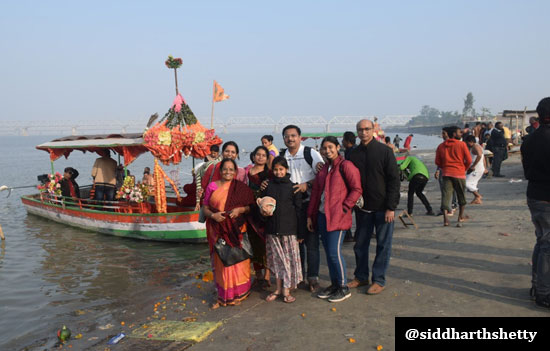 My family on the banks of the Saryu river.
My family on the banks of the Saryu river.
As we traversed Ayodhya town in our tuk-tuks to
reach the parking spot of our Tempo Traveler, we could see that several old
residential buildings in the city were razed to the ground. This was the
groundwork being laid for the Ayodhya religious corridor on the lines of
Varanasi. I think Ayodhya will be much more easier to navigate through once
this corridor is completed. We returned to the hotel by evening and explored
local chat joints. Stayed overnight at the hotel.
Day 4 Reached Kashi
In the morning, we began our journey by road for
the last leg of our trip to Kashi/Benaras/Varanasi, also called The City of
Light.
The original name for this place was Anandvan. It later become Kashi in ancient times. During the Mughal rule Benaras came up to be the name for this ancient city and Varanasi is the modern name for this city. Mark Twain had once remarked “Banaras is older than history, older than tradition, older even than legend, and looks twice as old as all of them put together.”
Kashi is considered to be one of the oldest continuously inhabited cities in the world. We had lunch near Jaunpur which is just before you arrive at Varanasi. We entered the heavy traffic laden roads of
Varanasi post lunch.
What surprised me was that Varanasi came across as the most developed city out of the three cities we visited on this trip. Even more so, it was much cleaner than Ayodhya and certainly many times better than Prayagraj in terms of not seeing garbage on the roads. You can sense that this being the Prime Minister’s constituency, it was living up to its reputation as a cleaner city compared to other cities of Uttar Pradesh.
We had plans to conduct the pind-daan ceremony for my
deceased father and other ancestors via priests from the Udupi Shri Krishna
Math at Assi Ghat. Hence, this is where
we landed post noon. Assi Ghat is named after the now almost extinct Assi River.
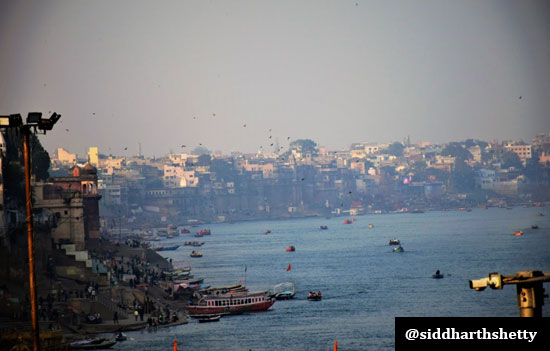 View from Udupi Sri Krishna Math at Assi ghat.
View from Udupi Sri Krishna Math at Assi ghat.
I noticed that almost each region in India found
representation through the numerous ghats/maths in Kashi. This way people
coming from different parts of India could find a place that they could get
help from in order to manage the ceremonies that might have planned in Kashi.
We met the head priest of Udupi Shri Krishna
Math and finalized plans for the next day. We checked into hotel Benaras Haveli
near Assi Ghat and dropped our luggage in the rooms. At 5 pm we got on to a
private boat which took us upstream to Dashashwamedh Ghat where the famous
Ganga aarti is performed.
The boat ride at twilight time was one of the most surreal
experiences I have had in my lifetime. Seeing
each ghat pass by and people perform different activities near the ghats was
almost an unreal experience. You can almost visualize how these ghats were a
mute witness to hundreds (if not thousands) of years of human civilization. It
reminded me of the time warp scene from the movie Interstellar where Cooper is
caught in a five dimensional tesseract and see different moments in his
lifetime in the tesseract.
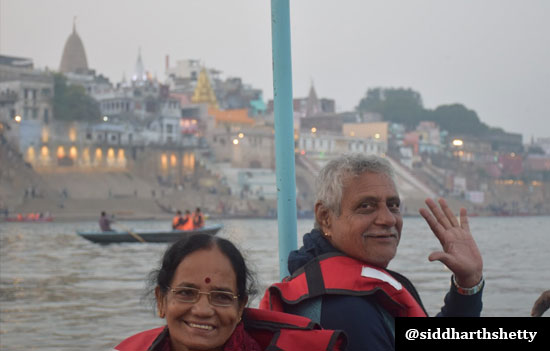 My in-laws enjoying the twilight time boat ride
to Dashashwamedh ghat from Assi ghat.
My in-laws enjoying the twilight time boat ride
to Dashashwamedh ghat from Assi ghat.
We could see people bathing, some offering pinds
to the water and also funeral pyres lit alongside the holy river Ganga. At 6 pm
the Ganga aarti began and it was a magical 30-40 mins spent at Dashashwamedh
ghat seeing the aarti from our boat. The chanting of the priests, the chorus of
the crowds and the mesmerizing sound of bells was a very therapeutic experience
for our souls.
 Experiencing the Ganga aarti from a boat near Dashashwamedh Ghat.
Experiencing the Ganga aarti from a boat near Dashashwamedh Ghat.
 Entrance to Kashi Vishwanath Corridor from Ma Ganga side.
Entrance to Kashi Vishwanath Corridor from Ma Ganga side.
We returned to Assi ghat by 7 pm to the starting point of the boat ride. This private boat for our family of 10 people cost us 3,500 rupees. Had dinner at one of the hotels near Assi ghat
and retired for the night.
Day 5 Kashi
The main plan for this day was to have early
morning darshan of Shri Kashi Vishwanath. Hence, we set the alarm for 2 am and everyone was ready
after our early morning bath at 3. The contact provided to us by Udupi Shri
Krishna Math was waiting for us at the hotel lobby.
We took 2 rickshaws (Rs 500 for each rickshaw)
to reach the gates of the Kashi Vishwanath temple. These rickshaws would take
us around the other temples too. We got in line at around 3.30 am but there was
already a queue of people ahead of us. We had a couple of elderly people with
us namely my mom and father-in-law who had mobility problems, so we took up the
VIP queue option which costs around Rs 200 each. There was a queue here too,
but it was much less than the general queue. Again, electronic devices
including smart watches and food items were not allowed inside the temple. You
can leave your belongings at one of the numerous lockers available around the
temple.
The temple gates opened at 4 am and after
security checks and standing in queue for some time we finally got the darshan
of Kashi Vishwanth Shankar Bhagwaan at 4.30 am. It was a profoundly powerful
moment when we were able to touch the Shiv ling inside the main temple. Post
this very fulfilling and uplifting darshan we performed abhishek at the temple where we offered milk abhishek as a family
to another shiv-linga in the premises of the temple. The final abhisheka was
done at the main linga. The temple has stopped darshan from close quarters post
5.30 am and you can only see the shiv-linga from a distance after this time.
The abhishek process took us about 30 mins of time. We also spotted the
original Nandiji facing the other side still waiting for the sight of his lord
even after many centuries. Was saddening to see Nandiji lying in wait.
Post this early morning darshan of Kashi
Vishwanathji, we visited several temples in the cute alleyways of Kashi.
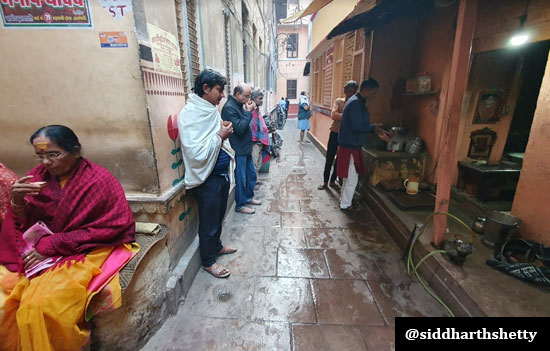 The cute alleyways of Kashi
The cute alleyways of Kashi
My daughter fell in love with the cute
alleyways which were used by people on foot, bicycles and even cows. Many of
the houses in these cute alleyways had intricate doors done up in vibrant
colour schemes.
 My daughter enjoyed taking pictures in front of the doors in these alleyways
My daughter enjoyed taking pictures in front of the doors in these alleyways
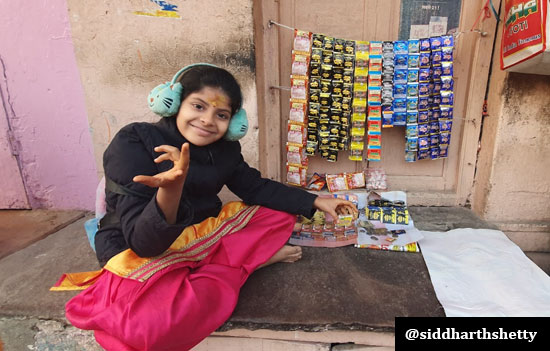 Daughter could not resist the temptation to act as a paanwaala
Daughter could not resist the temptation to act as a paanwaala
Kashi has hundreds of temples but we visited
some of the most popular ones namely Annapurna Devi
temple, Vishalakshi devi temple, Kaal Bhairav temple, Bindu Mahadev temple.
After this we had breakfast at Assi ghat.
Post breakfast we began the pinda-daan ceremony
for my father and other ancestors at 10 am at Udupi Shri Krishna Math at Assi
ghat. My brother-in-law also performed the same ceremony in memory of his
father and other deceased ancestors. Even though the main goal of the pind-daan
was to pray for mukti for my deceased
father, the priest undertaking the ceremony also asked me to remember my other
deceased ancestors.
This was a fairly emotional process for me as I remembered my ever-loving maternal and paternal grandmothers and my doting maternal grandfather. My paternal grandfather has passed away before I was born hence I did not have any memories of him. Post the ceremony, my brother in law and I, hired a manual row boat for Rs 200/ to take us to the centre of the Ganga river to offer the pindas to the holy waters of the Ganga. It was an emotional moment as the ‘pindas’ dropped into the heart of the Ganga river and I thanked my father and grandparents for all that they had done for me.
What surprised me is that the boatman requested us to throw away the ‘pind-daan’ plates made of leaves into the dust-bin near the shore instead of throwing them in the water.
Both of us had anyways decided to drop the
plates in the dust bin but we were happy to see how the locals were playing an
important role in the Namami Gange
clean-up project. Even with the best intentions and efforts of the government,
such cleanliness projects can succeed only when the masses actively support
such projects.
Post pinda-daan, we hired a private boat (cost Rs
1200/) to take us to the opposite bank of the river Ganga which is considered
to be safer for Ganga snan. This was one of the best decisions we took during
this trip. Even though the water was ice cold, the water itself was very clean
and refreshing. It was a very fulfilling experience to have Ganga snan with
family in the safe waters of this opposite bank.
We also filled up a few empty water bottles with Ganga jal
and it was amazing to see the clarity of the water in these bottles. Places like Rishikesh and Haridwar which are upstream can certainly have cleaner water from the Ganga water but I did not expect the Ganga waters to be so clean at a downstream city like Kashi.
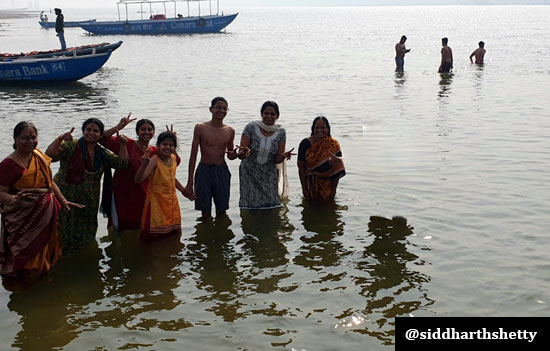 The very refreshing and uplifting Ganga snan performed by my family.
The very refreshing and uplifting Ganga snan performed by my family.
Post the very fulfilling Ganga Snan, we had
lunch at Udupi Shri Krishna Math at Assi ghat. After lunch we proceeded to try
some chat at Kashi Chat Bhandar and lassi and malaio at Pehelwan
lassi. Tamatar Chat at the former is popular.
![]()
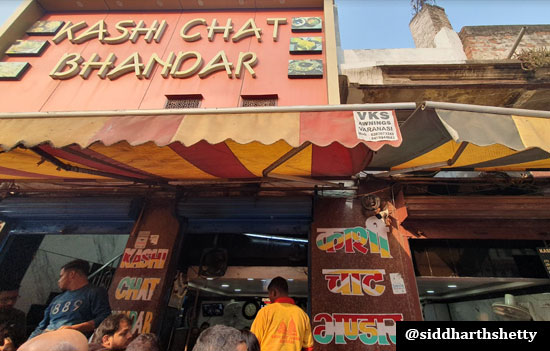 Kashi Chat Bhandar.
Kashi Chat Bhandar.
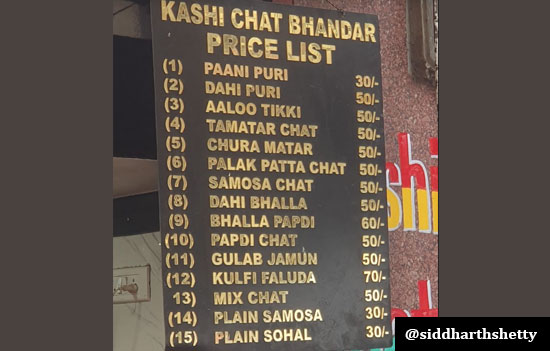 Kashi Chat Bhandar Menu.
Kashi Chat Bhandar Menu.
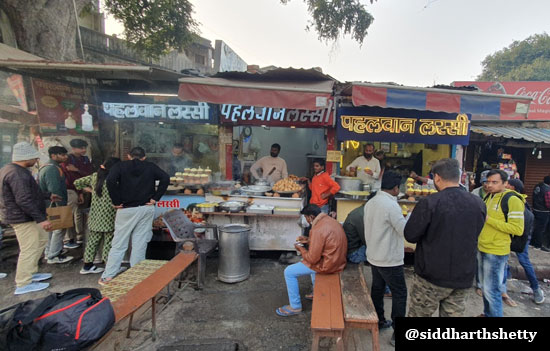 Pehelwan Lassi.
Pehelwan Lassi.
After this round of snacks we proceeded, via
the Tempo Traveller, to Sankat Mochan Hanman Temple, Birla temple in Benaras
Hindu University Campus and we ended this spiritual journey at Kavdi Mata temple. It is said that your Kashi yatra is complete once you offer “kavdis” to the Kavdi Mata temple. You also get one “kavdi” back from the temple priest to be kept in your temple at home as a memory of this trip.
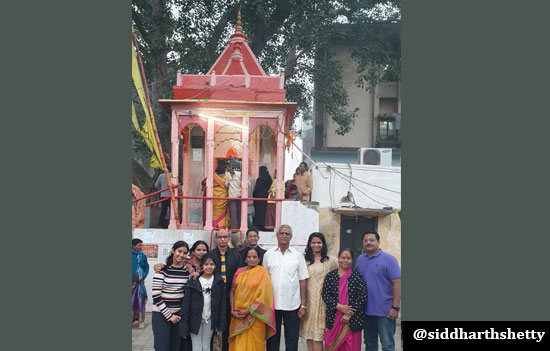 The entire family outside Kavdi Mata temple after successful completion of our Kashi trip.
The entire family outside Kavdi Mata temple after successful completion of our Kashi trip.
We returned to the hotel by evening and had
dinner at the hotel.
Day 6 Return to Pune
Started for the airport at 8 am for our 11.30 flight
from Varanasi airport. Due to foggy conditions our flight was delayed but it
eventually took off at 1 pm. Some of our other acquaintances that we met on
this trip to Kashi said that their early morning and late evening flights had
been cancelled due to the fog. Hence, we were quite lucky to have got on to our
flight. Our flight was from Varanasi to Mumbai since we could not get any
flights from Varanasi to Pune.
We landed at Mumbai airport around 3.30 pm and
sStepped out of the airport by 4.30. Had already booked two Innovas for the
ride back to Pune. Due to heavy traffic while getting out of Mumbai and traffic
between Chandni chowk and Warje, we reached our home in Pune by 10 pm (took us
5.5 hours to reach Pune from Mumbai) but we were not complaining and we were
just happy to be back home after a very enriching and fulfilling trip to
Prayagraj, Ayodhya and Kashi.
At the end of this trip seeing the smiles and the sense of fulfilment on the faces of my mother and in-laws was a fitting end of this trip. All is well that ends well.
Our tour operator was Darshan Travels owned by Shri
Sudhir Karhadkar. Sudhir Bhai can be reached on +91 98502 41515.
Also read
1. Album
Ghats of Kashi
2. Album
Dev Deepavali Kashi
3. Album Sarnath
near Kashi
4. Album
Ramnagar Fort near Kashi
5. Why
do devotees visit Kashi
6. Varanasi – A Passage to Immortality
7. Maratha
contributions to culture of Kashi
8. Banarsi
Saree